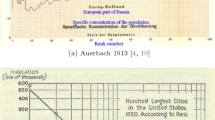Abstract
We have investigated the population distribution of Chinese cities from 1997 to 2006. The rank-size distributions of Chinese cities deviate from the Pareto distribution. For city size distribution of each year we can find a population threshold P c that characterizes the boundary of the deviation. The cities with population more than P c follow the Pareto distribution, while the smaller cities deviate from the Pareto distribution. Using P c for every year, the rank-size distribution from 1997 to 2006 can be written into a scaling form \(R(P,T)= C(T)P^{-\alpha (T)}f(P/P_c (T))\), where the Pareto exponent α(T) is not equal to the value of Zipf’s law and evolutes with time. According this scaling form, the data of the city size distributions of Chinese cities from 1997 to 2006 can collapses to a single curve, which is the scaling function of the city size distribution.
Access this chapter
Tax calculation will be finalised at checkout
Purchases are for personal use only
Preview
Unable to display preview. Download preview PDF.
Similar content being viewed by others
References
National Bureau of Statistics: China Urban Statistical Yearbook. China Statistics Press, Beijing (1998-2007)
Soo, K.T.: Zipf’s Law for cities: a cross-country investigation. Regional Science and Urban Economics 35(3), 239–263 (2005)
Dobkins, L.H., Ioannides, Y.M.: Dynamic Evolution of the U.S. City Size Distribution. Discussion Papers Series, Department of Economics, Tufts University (1999)
Zipf, G.K.: National Unity and Disunity. The Principia Press, Bloomington Indiana (1941)
Rosen, K.T., Resnick, M.: The Size Distribution of Cities: An Examination of the Pareto Law and Primacy. Journal of Urban Economics 8(2), 165–186 (1980)
Husing, Y.: A note on functional forms and the urban size distribution. Journal of Urban Economics 27, 70–73 (1990)
Laherrere, J., Sornette, D.: Stretched exponential distributions in nature and economy: ”fat tails” with characteristic scales. The European Physical Journal B 2, 525–539 (1998)
Gan, L., Li, D., Song, S.: Is the Zipf law spurious in explaining city-size distributions? Economics Letters 92(2), 256–262 (2006)
Benguigui, L., Blumenfeld-Lieberthal, E.: Beyond the power law - a new approach to analyze city size distributions. Computers, Environment and Urban Systems 31, 648–666 (2007)
Batty, M.: The Size, Scale, and Shape of Cities. Science 319, 769–771 (2008)
Bettencourt, L.M.A., Lobo, J., Helbing, D., Kuhnert, C., West, G.B.: Growth, innovation, scaling, and the pace of life in cities. Proceedings of the National Academy of Sciences of the United States of America 104(17), 7301–7306 (2007)
Isalgue, A., Coch, H., Serra, R.: Scaling laws and the modern city. Physica A: Statistical Mechanics and its Applications 382(2), 643–649 (2007)
Privman, V., Hohencerg, P.C., Aharony, A.: Universal Critical-Point Amplitude Relations. In: Domb, C., Lebowitz, J.L. (eds.) Phase Transitions and Critical Phenomena, vol. 14, p. 1. Academic Press, New York (1991)
Song, S., Zhang, K.H.: Urbanisation and City Size Distribution in China. Urban Studies 39(12), 2317–2327 (2002)
Eeckhout, J.: Gibrat’s Law for (All) Cities. The American Economic Review 94(5), 1429–1451 (2004)
Anderson, G., Ge, Y.: The size distribution of Chinese cities. Regional Science and Urban Economics 35(6), 756–776 (2005)
Author information
Authors and Affiliations
Editor information
Editors and Affiliations
Rights and permissions
Copyright information
© 2009 ICST Institute for Computer Science, Social Informatics and Telecommunications Engineering
About this paper
Cite this paper
Zhu, X., Xiong, A., Li, L., Liu, M., Chen, X. (2009). Scaling Behavior of Chinese City Size Distribution. In: Zhou, J. (eds) Complex Sciences. Complex 2009. Lecture Notes of the Institute for Computer Sciences, Social Informatics and Telecommunications Engineering, vol 4. Springer, Berlin, Heidelberg. https://doi.org/10.1007/978-3-642-02466-5_86
Download citation
DOI: https://doi.org/10.1007/978-3-642-02466-5_86
Publisher Name: Springer, Berlin, Heidelberg
Print ISBN: 978-3-642-02465-8
Online ISBN: 978-3-642-02466-5
eBook Packages: Computer ScienceComputer Science (R0)




